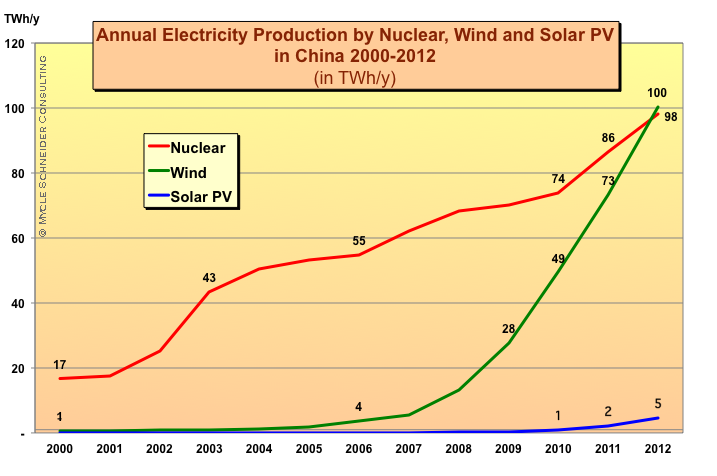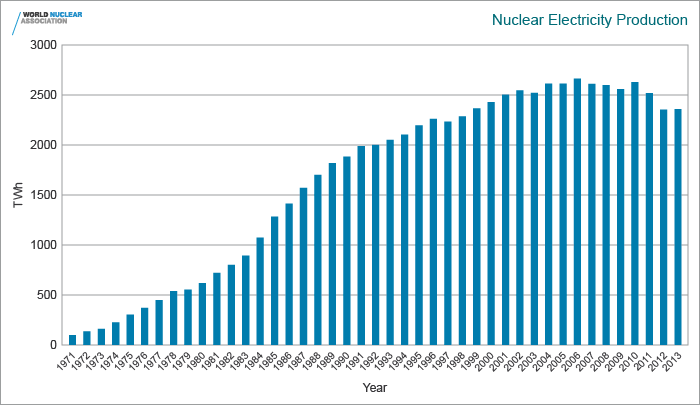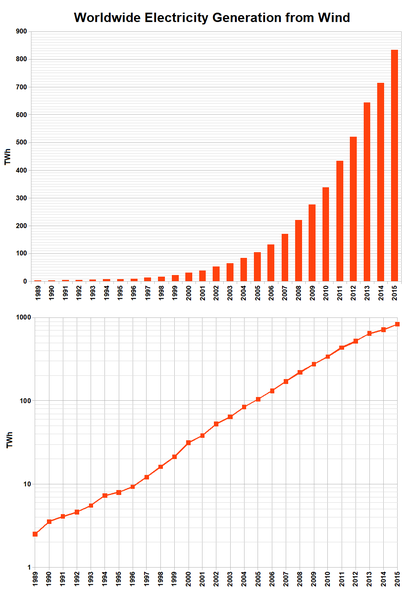Power Raid
We Exist To Win Premierships
Is there any evidence of this?
The price of nuclear hasn't reduced any time recently. After Fukushima it's very likely that nuclear costs will only increase with greater safety standards required and higher insurance costs. Nuclear also has significant costs associated with decommissioning plants that are often pushed on to taxpayers which makes costs worse than what they appear.
Without a major step up in technology (such as fusion or burning U-238) then I don't see how costs reduce for nuclear. It's already a very mature technology. Unfortunately these breakthroughs are likely to be decades away. Considering the long lead-in time for nuclear plants these technologies, if they do arrive and are cost effective, are unlikely to be widespread for a couple of decades after that.
In contrast wind is already far cheaper than nuclear in places suited to it and is decreasing in costs. We're still far short of capacity in wind in Australia. Solar costs are not that much more expensive than nuclear on a levelised basis and are plummeting at a rapid rate. Smarter use of grids and smarter usage control can go a long way to overcoming some of the major problems with renewables (for example over large areas wind's intermittent behaviour significantly reduces). There are of course issues that need to be solved with renewables with storage being the major one but the solutions seem much more feasible in the short to medium term than nuclear.
I'm not against nuclear and think research needs to be made in to improvements. In fact a couple of years ago I thought it was the most likely candidate to overcome fossil fuels. But in its current form nuclear just doesn't stack up economically. Since then nuclear prices haven't decreased and renewable prices have plummeted. The situation has changed and our energy make-up should change with it.
Your right re a US perspective but find the following table comparing Europe and China:

http://en.wikipedia.org/wiki/AP1000
http://www.ap1000.westinghousenuclear.com/ap1000_ec.html
Commercial
Operation* REACTOR TYPE MWe (net)
2013 Iran, AEOI Bushehr 1* PWR 950
2013 India, NPCIL Kudankulam 1 PWR 950
2013 India, NPCIL Kudankulam 2 PWR 950
2013 China, CGNPC Hongyanhe 1* PWR 1080
2013 China, CGNPC Ningde 1* PWR 1080
2013 Korea, KHNP Shin Wolsong 2 PWR 1000
2013 Korea, KHNP Shin-Kori 3 PWR 1350
2013 Russia, Rosenergoatom Leningrad II-1 PWR 1070
2013 Argentina, CNEA Atucha 2 PHWR 692
2013 China, CGNPC Ningde 2 PWR 1080
2013 China, CGNPC Yangjiang 1 PWR 1080
2013 China, CGNPC Taishan 1 PWR 1700
2013 China, CNNC Fangjiashan 1 PWR 1080
2013 China, CNNC Fuqing 1 PWR 1080
2013 China, CGNPC Hongyanhe 2 PWR 1080
2014 Russia, Rosenergoatom Novovoronezh II-1 PWR 1070
2015 Russia, Rosenergoatom Rostov 3 PWR 1070
2014 Slovakia, SE Mochovce 3 PWR 440
2014 Slovakia, SE Mochovce 4 PWR 440
2014 Taiwan Power Lungmen 1 ABWR 1300
2014 China, CNNC Sanmen 1 PWR 1250
2014 China, CPI Haiyang 1 PWR 1250
2014 China, CGNPC Ningde 3 PWR 1080
2014 China, CGNPC Hongyanhe 3 PWR 1080
2014 China, CGNPC Yangjiang 2 PWR 1080
2014 China, CGNPC Taishan 2 PWR 1700
2014 China, CNNC Fangjiashan 2 PWR 1080
2014 China, CNNC Fuqing 2 PWR 1080
2014 Korea, KHNP Shin-Kori 4 PWR 1350
2014? Japan, Chugoku Shimane 3 ABWR 1375
2014 India, Bhavini Kalpakkam FBR 470
2014 Russia, Rosenergoatom Beloyarsk 4 FNR 750
2015 USA, TVA Watts Bar 2 PWR 1180
2015 Taiwan Power Lungmen 2 ABWR 1300
2015 China, CNNC Sanmen 2 PWR 1250
2015 China, CGNPC Hongyanhe 4 PWR 1080
2015 China, CGNPC Yangjiang 3 PWR 1080
2015 China, CGNPC Ningde 4 PWR 1080
2015 China, CGNPC Fangchenggang 1 PWR 1080
2015 China, CNNC Changjiang 1 PWR 650
2015 China, CNNC Changjiang 2 PWR 650
2015 China, CNNC Fuqing 3 PWR 1080
2015 India, NPCIL Kakrapar 3 PHWR 640
2015? Japan, EPDC/J Power Ohma 1 ABWR 1350
2016 Finland, TVO Olkilouto 3 PWR 1600
2016 France, EdF Flamanville 3 PWR 1600
2016 Russia, Rosenergoatom Novovoronezh II-2 PWR 1070
2016 Russia, Rosenergoatom Leningrad II-2 PWR 1200
2016 Russia, Rosenergoatom Vilyuchinsk PWR x 2 70
2016 India, NPCIL Kakrapar 4 PHWR 640
2016 India, NPCIL Rajasthan 7 PHWR 640
2016 Pakistan, PAEC Chashma 3 PWR 300
2016 China, China Huaneng Shidaowan HTR 200
2016 China, CPI Haiyang 2 PWR 1250
2016 China, CGNPC Yangjiang 4 PWR 1080
2016 China, CGNPC Hongyanhe 5 PWR 1080
2015 China, CNNC Hongshiding 1 PWR 1080
2015 China, CGNPC Fangchenggang 2 PWR 1080
2016 China, several others PWR
2017 USA, Southern Vogtle 3 PWR 1200
2017 Russia, Rosenergoatom Baltic 1 PWR 1200
2017 Russia, Rosenergoatom Rostov 4 PWR 1200
2017 Russia, Rosenergoatom Leningrad II-3 PWR 1200
2017 Ukraine, Energoatom Khmelnitsky 3 PWR 1000
2017 Korea, KHNP Shin-Ulchin 1 PWR 1350
2017 India, NPCIL Rajasthan 8 PHWR 640
2017 Romania, SNN Cernavoda 3 PHWR 655
2017? Japan, JAPC Tsuruga 3 APWR 1538
2017 Pakistan, PAEC Chashma 4 PWR 300
2017 USA, SCEG Summer 2 PWR 1200
2017 China, several
2018 Korea, KHNP Shin-Ulchin 2 PWR 1350









